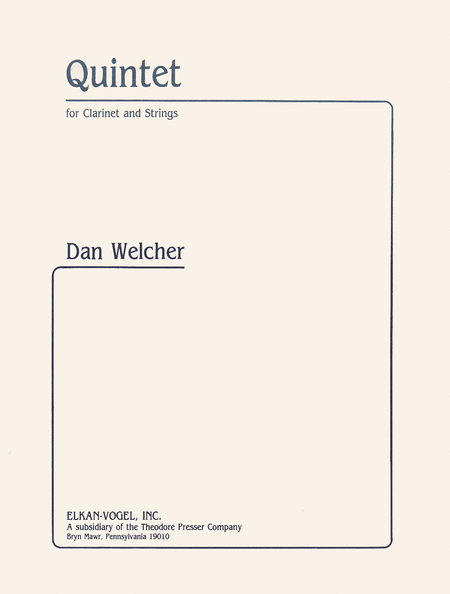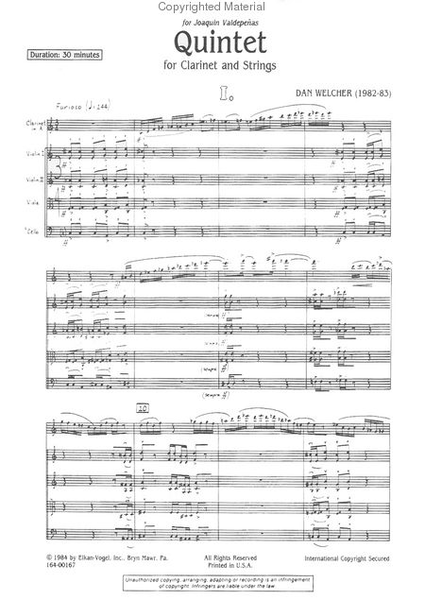Quintet
For Clarinet and Strings - Score and Parts
-
Ships in 1 to 2 weeks
Details
Description
SKU: PR.164001670
For Clarinet and Strings - Score and Parts. Composed by Dan Welcher. Premiered May 1, 1983 at Town Hall, New York City with Joaquin Valdepenas, clarinet, and the Muir String Quartet. Set of Score and Parts. With Standard notation. Composed 1983. Duration 30 minutes. Theodore Presser Company #164-00167. Published by Theodore Presser Company (PR.164001670).UPC: 680160036936.
My QUINTET for Clarinet and Strings was commissioned by clarinetist Joaquin Valdepenas in 1982. As is my custom regarding commissioned works, I asked Joaquin nearly a thousand questions about the kind of work he wanted: length, difficulty, general spirit (in terms of matching it with other works for programming purposes), etc. I want a piece to rival the Brahms Quintet, he said, which meant a work of nearly symphonic proportions and seriousness of intent. I set as my goal a three movement piece with a total duration of about thirty minutes. It seemed best to make the first movement the most developed and symphonic, with an intermezzo of lighter weight for the middle movement, and a theme and variations for the finale...in other words, to write a Romantic work. The result was not far from the initial concept, for a change. I had been working toward a more tonally based music for some time, and this commission (which carried with it the enticing promise of a premiere in Town Hall with the excellent Muir Quartet) provided me with an incentive to finally write a substantial piece of chamber music with all the breadth and inner construction of the nineteenth century. The first movement is an extended sonata form with an introduction and fugue appended to it. Toward the end of the development section, a little march tune is introduced, seemingly unrelated to the rest of the material. In fact, this little melody becomes the basis of the middle section of the second movement, and (in inversion) supplies the theme itself for the Theme and Variations finale. The Intermezzo has much to do with rhythmic play, with the pizzicato strings playing in changing meters at the outset while the solo clarinet (later joined by the first violin) sings a very simple melody in straight 2/4 time. The middle of the Intermezzo (which is a simple ternary form) is a chorale in the strings, with flights of fantasy in the solo clarinet between the phrases. Textures of glissandi, harmonics bowed and plucked, and other impressionistic techniques give this movement a somewhat exotic nature. The final movement presents a theme of almost English folksong quality, but which on analysis proves to be the aforementioned germinal melody in inversion. Five variations follow, ranging in style from energetic to agitated, pastoral to jazzy, and finally to exuberant and dancelike. (The fourth variation takes us, for reasons that must remain private, to New Orleans' Preservation Hall!). The work ends with an affirmation of tonality and of life itself, in unashamed A Major.
Song List (3)
- I.
- Ii. (Intermezzo)
- III.


 Share
Share